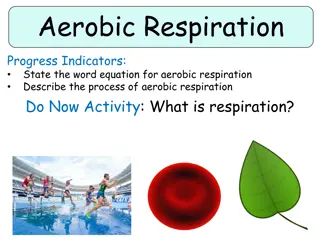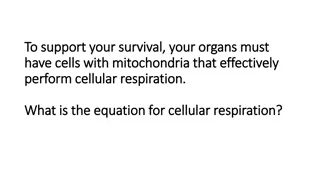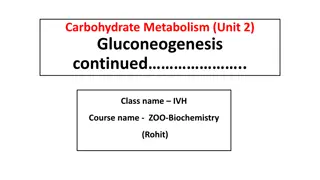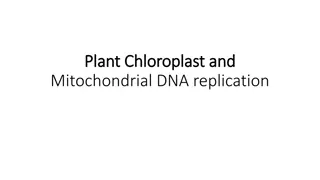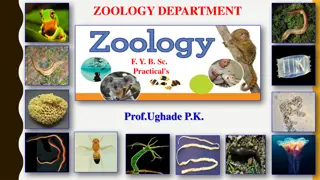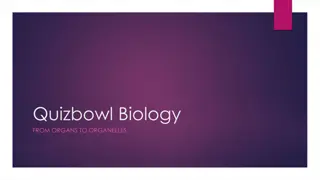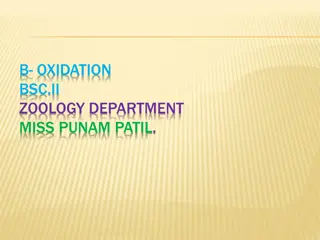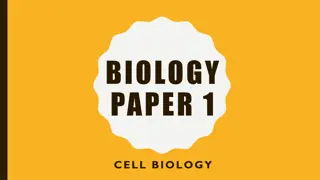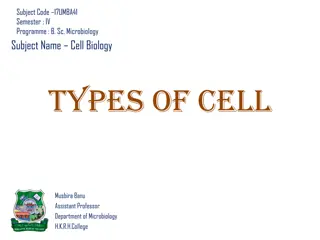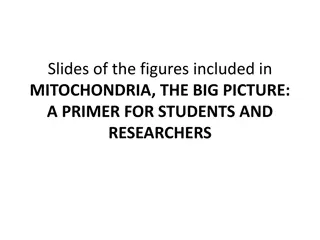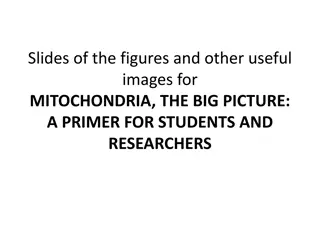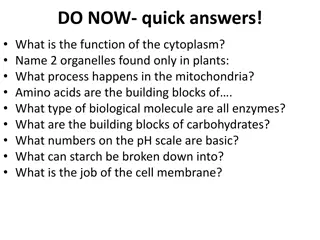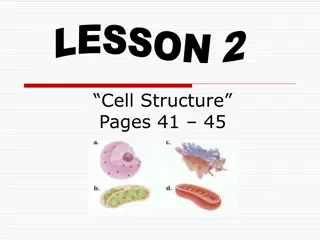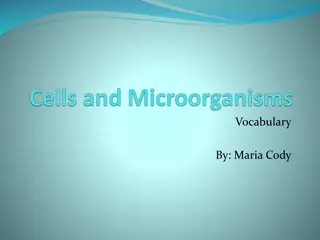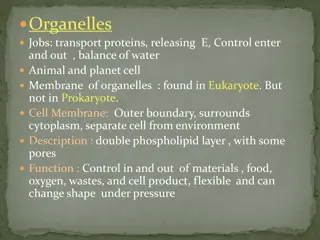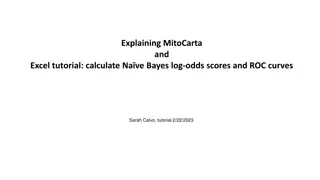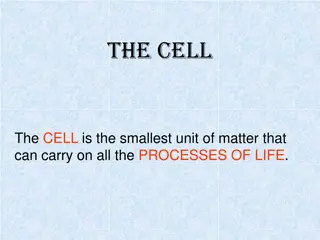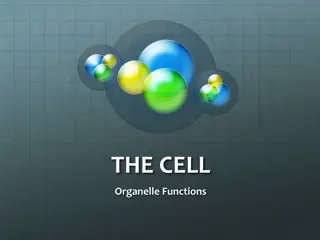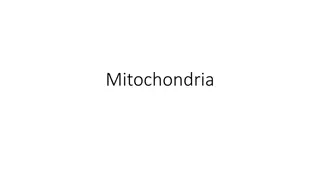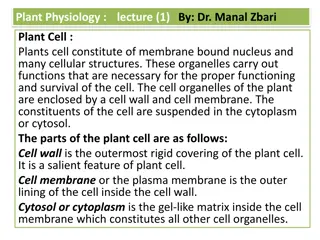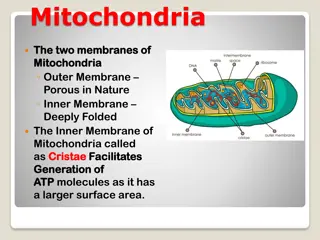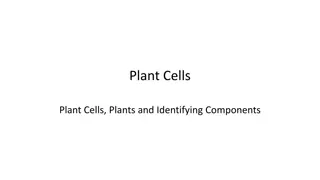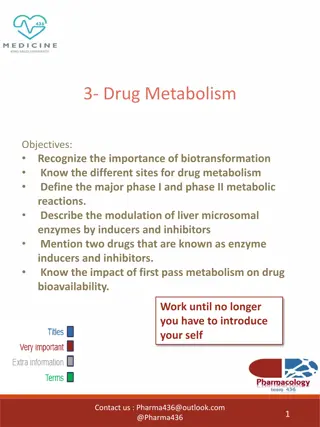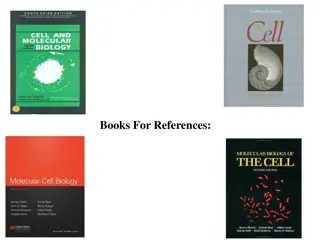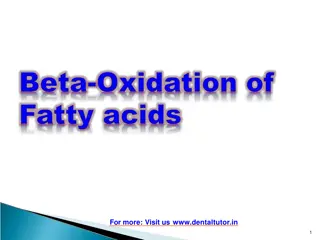Aerobic Respiration and Cell Structures
Explore the process of aerobic respiration, why we need oxygen for energy production, and the importance of cell structures in this metabolic pathway. Discover the role of key organelles like mitochondria and the cell membrane, as well as the differences between animal and plant cells in respiration
0 views • 10 slides
Cellular Respiration and Oxygen Delivery
Cellular respiration, a vital process for organ survival, involves mitochondria performing cellular respiration by utilizing glucose and oxygen. Glucose is derived from diet or body breakdown, while oxygen enters through the respiratory system, facilitated by red blood cells in the circulatory syste
0 views • 8 slides
Gluconeogenesis: Pyruvate to Phosphoenolpyruvate Conversion in Carbohydrate Metabolism
Gluconeogenesis is a crucial pathway where pyruvate is converted to phosphoenolpyruvate through multiple steps involving enzymes like pyruvate carboxylase and phosphoenolpyruvate carboxykinase. This process occurs in the mitochondria and cytosol, requiring coenzymes like biotin and GTP. Alternate pa
0 views • 22 slides
Plant Mitochondrial and Chloroplast DNA Replication Mechanisms
Plant mitochondria and chloroplasts have intricate DNA replication processes. Mitochondrial DNA replication is independent of the plant cell cycle and is associated with specific proteins in nucleoid complexes. Plant mtDNA contains more genes than animal mtDNA, with a complex structure involving int
1 views • 16 slides
Classification and Characteristics of Phylum Protozoa
Phylum Protozoa comprises unicellular, microscopic, eukaryotic organisms found mostly in aquatic habitats. They exhibit diverse locomotory structures such as cilia, flagella, or pseudopodia. These protists may possess a cellulose cell wall and various membrane-bound organelles like mitochondria and
0 views • 21 slides
Cellular Structures in Quizbowl Biology
Biology in quizbowl competitions often focuses on understanding cellular structures, from organs to organelles. Players encounter questions about various organelles like mitochondria, ribosomes, chloroplasts, and the Golgi body. Ribosomes, though not classified as organelles, play a critical role in
0 views • 27 slides
Fatty Acid Oxidation in Zoology Department with Miss Punam Patil
Explore the process of fatty acid oxidation in zoology, including the entry of fatty acids into mitochondria, TCA cycle outcomes, and differences between mitochondrial and peroxisomal oxidation. Learn about the oxidation of saturated, monounsaturated, and polyunsaturated fatty acids through detailed
0 views • 9 slides
Cell Biology Overview and Organ Systems in Biology Paper 1
The Biology Paper 1 content covers topics such as cell specializations, cell division, organelles, enzyme functions, and organ systems including the cardiovascular system. It discusses key concepts like stem cells, mitosis, diffusion, osmosis, active transport, and various cell components such as nu
0 views • 8 slides
Comparison of Eukaryotic and Prokaryotic Cells in Cell Biology
Cells are the fundamental units of life, but viruses are an exception as they lack cells. Eukaryotic cells have a defined nucleus with a nuclear membrane housing chromosomes, while prokaryotic cells lack a membrane-bound nucleus and other organelles. Eukaryotic cells are larger, containing membrane-
0 views • 9 slides
Mitochondria: A Visual Overview for Researchers
Dive into the world of mitochondria with a collection of detailed figures, showcasing thin section views, fluorescent protein labeling, schematic representations of mitochondrial compartments, and involvement in processes like apoptosis and biogenesis. Discover the intricate structures and functions
0 views • 12 slides
Mitochondria: Images and Insights for Researchers
Dive into the world of mitochondria with a collection of informative images showcasing aspects like mitochondrial reticulum, fluorescent protein labeling, electron micrograph views, and schematic diagrams of mitochondrial compartments. Learn about metabolic pathways, cellular energy control, mTOR si
0 views • 20 slides
Cellular Processes and Functions Explained
The cytoplasm is essential for cell function, housing organelles like chloroplasts and vacuoles unique to plants. Mitochondria facilitate cellular respiration, while amino acids form proteins. Enzymes are proteins, and carbohydrates consist of simple sugars. Basic pH numbers range from 8 to 14. Star
0 views • 24 slides
Cell Structure: Key Organelles and Functions
Explore the intricate world of cell structure as we delve into the functions of essential organelles such as chloroplasts, mitochondria, ribosomes, endoplasmic reticulum, Golgi bodies, vacuoles, lysosomes, and the nucleus. Uncover the significance of each organelle in maintaining the cell's processe
0 views • 13 slides
Biology: Key Terms and Concepts in Cell Biology
Dive into the fascinating world of biology with a focus on essential terms and concepts in cell biology. Learn about the structures and functions of cells, from bacteria to organelles, and understand the fundamental components that make up living organisms. Explore the roles of mitochondria, nucleus
0 views • 18 slides
Fascinating Vocabulary of Cell Biology
Explore the intricate world of cell biology through fancy terminology for basic cell components, such as the cell membrane, cytoplasm, mitochondria, nucleus, and more. Discover the unique functions and structures of plant and animal cells as compared to different types of cells within each class. Vi
0 views • 19 slides
Cell Organelles and Their Functions
Cell organelles play vital roles in the functioning of both animal and plant cells. From the cell membrane that controls the exchange of materials to the nucleus that governs cell activities, each organelle contributes uniquely. The cytoplasm provides a supportive environment for organelles, while t
0 views • 6 slides
MitoCarta and Naive Bayes Integration in Excel Tutorial
Explore the process of calculating Naive Bayes log-odds scores and ROC curves in Excel using the MitoCarta dataset. Discover the best experimental techniques for isolating mitochondria in Arabidopsis studies, comparing methods like differential centrifugation and affinity purification.
0 views • 31 slides
Unraveling the Origins of Our Canine Companions
This article delves into the fascinating history of domesticated dogs and their ancestors, shedding light on their evolution dating back over 13,000 years. Bioarchaeologists' studies of animal bones reveal insights into mitochondria and energy production within cells. Despite challenges in tracing t
0 views • 10 slides
The Fascinating World of Cells and Organelles
Delve into the intriguing realm of cells and organelles, the building blocks of life. Discover the origins of the cell theory, the contributions of pioneers like Anton von Leeuwenhoek and Robert Hooke, and the essential functions of key organelles like the cell membrane, nucleus, mitochondria, and m
0 views • 31 slides
The Functions of Cell Organelles
Explore the vital functions of different cell organelles such as the cell membrane, nucleus, endoplasmic reticulum, lysosomes, Golgi apparatus, mitochondria, cytoplasm, ribosomes, vacuole, cell wall, chloroplasts, and chlorophyll in a cell. Learn how each organelle plays a unique role in maintaining
0 views • 38 slides
Structure and Function of Mitochondria
Mitochondria, derived from Greek words meaning thread and granule, are essential organelles found in eukaryotic cells. They serve as energy powerhouses, metabolizing carbohydrates and fatty acids to produce adenosine triphosphate (ATP). The inner and outer membranes of mitochondria contain proteins
0 views • 14 slides
Plant Cell Physiology and Functions
Plant cells are the fundamental units of life in the Plantae kingdom, comprising various organelles like the nucleus, chloroplasts, and mitochondria. These cells perform essential functions such as photosynthesis, cellular respiration, and storage. Differentiated by their unique cell walls, chloropl
1 views • 24 slides
Mitochondria, Plastids, and Chloroplasts in Cells
Mitochondria, known as the powerhouse of the cell, generate ATP for energy production through cellular respiration. Plastids, such as leucoplasts, store various compounds like starch and proteins. Chloroplasts conduct photosynthesis in plants, utilizing chlorophyll and performing light-dependent rea
0 views • 10 slides
Plant Cell Components: Nucleus, Cell Wall, Mitochondria, Cytoplasm, Chloroplasts
Plant cells consist of various components like the nucleus, cell wall, mitochondria, cytoplasm, and chloroplasts, each serving specific functions essential for the plant's growth and survival. The nucleus houses genetic information, the cell wall provides support, mitochondria produce energy, cytopl
0 views • 18 slides
Drug Metabolism: Importance and Mechanisms
Drug metabolism is a crucial process in the body that transforms drugs into forms easily excreted, affecting their efficacy and toxicity. This involves different sites such as the liver, kidney, and plasma, with enzymes in cellular organelles like cytoplasm and mitochondria playing key roles. First-
0 views • 13 slides
Animal Cell Organelles and Functions
Dive into the intricate world of animal cell organelles and their functions. From the plasma membrane to the nucleus, ribosomes, endoplasmic reticulum, Golgi apparatus, mitochondria, and more, uncover the essential components that drive cellular processes. Discover the roles these organelles play in
0 views • 7 slides
Cell Organization and Evolutionary Perspectives
Prokaryotic and eukaryotic cells are the basic units of all living matter. This article explores the differences in organization between these two cell types, their characteristics, and evolutionary relationships. From discussing cellular structures to the presence of endomembranes, mitochondria, an
0 views • 66 slides
The Intriguing World of Mitochondria: Mitos and Chondrion Granule
Delve into the fascinating realm of mitochondria and explore the functions of Mitos and Chondrion Granule. Understand the vital role these cellular components play in energy production and overall cell health. Gain insights into the structure, function, and significance of mitochondria in cellular p
0 views • 21 slides
Biochemical Mechanisms of ATP Generation in Respiration
Biochemical mechanisms of ATP generation in higher organisms and bacteria through respiration, fermentation, and photosynthesis. Focus on aerobic and anaerobic respiration, electron transport chain, and oxidative phosphorylation in mitochondria.
0 views • 46 slides
Beta-Oxidation of Fatty Acids: Process and Significance
Beta-oxidation is the sequential removal of two-carbon fragments from fatty acids, generating acetyl-CoA for energy production. This essential metabolic pathway involves three stages: activation of fatty acids, transport into mitochondria, and oxidation in the mitochondrial matrix. The process requi
0 views • 31 slides
Basics of Cell Biology Illustrated
This collection of informative cartoons covers various fundamental concepts in cell biology, including protein synthesis in ribosomes, energy conversion in mitochondria, organelle functions like the Golgi apparatus and lysosomes, cell theory principles, plant cell organelles, levels of organization,
0 views • 65 slides
Intro to Cellular Energy and Photosynthesis
Process of cellular energy production through ATP and photosynthesis in plants. Understand how organelles like chloroplasts and mitochondria play vital roles. Unravel the significance of ATP as an energy-storing molecule and the essential role of sunlight in photosynthesis. Get insights into how the
0 views • 8 slides
Cellular Respiration: Breaking Down Food for Energy Production
Carbohydrates, fats, and proteins are essential fuel sources for cellular respiration where glucose undergoes exergonic catabolism. Mitochondria play a crucial role in the process, with oxidation and reduction reactions facilitating electron transfer and ATP production via the Electron Transport Cha
0 views • 30 slides
